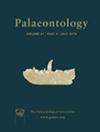概率绘图在古生物学中的应用
IF 2.3
2区 地球科学
Q1 PALEONTOLOGY
引用次数: 0
摘要
我们介绍了在生物和古生物形态测量数据分析中普遍使用的概率绘图。当应用于形态测量数据时,该分析工具可以产生古生态,个体发生和人口统计信息。我们已经调整和扩展了用于可靠性工程,机械或电气寿命分析,地球化学和矿石矿物分析的统计工具,以分析化石种群。该技术以“用户手册”的形式逐步解释。它的功能是表征统计分布类型,确定这些分布是否偏斜或截断,并解析和量化混合分布的组成部分,混合分布在古生物学数据中可能代表形态分组,如队列或两性异型。应用程序的易用性和简单性令人惊讶。生长序列数据的概率图(例如颅骨长度、股骨长度、鼻口到排气口长度或其他形态计量学)通常显示数据的复杂非正态分布,因为多模态组成。研究表明,这些成分模式通常是正常的,但并不总是正常的(即高斯分布),它们可以被分解,并且它们对应于每年的年龄组(队列)、性别异形、变质前和变质后的形式、其他个体发育阶段或可能的混合分类群。当这些成分的大小分布与年龄组或性别相关联时,一些重要的古生态学计算就成为可能。这些指标包括生长曲线、年龄和性别分布、两性二态性指数等。我们用几个例子证明了概率图在生物学和古生物学上的实用性,包括二叠纪无翅昆虫、现存的双壳类动物、三叠纪中甲纲两栖动物、现存的蜥蜴和三叠纪兽脚亚目恐龙。本文章由计算机程序翻译,如有差异,请以英文原文为准。
The utility of probability plotting in palaeobiology
We introduce probability plotting for general use in the analysis of biological and palaeontological morphometric data. When applied to morphometric data, this analytical tool can yield palaeoecological, ontogenetic and demographic information. We have adapted and expanded a statistical tool used in reliability engineering, mechanical or electrical lifetime analysis, geochemistry and ore mineral analysis to analyse fossil populations. The technique is explained stepwise in a ‘user's manual’ format. Its power is to characterize statistical distribution types, to determine whether these distributions are skewed or truncated, and to resolve and quantify the components of mixed distributions, which in palaeontological data potentially represent morphological groupings such as cohorts or sexual dimorphs. The ease of application and simplicity are surprising. A probability plot of growth series data (e.g. skull lengths, femoral lengths, snout‐to‐vent lengths or other morphometrics) typically shows complex non‐normal distribution of the data because of multimodal composition. We show that these component modes, which are generally, but not always normal (i.e. Gaussian), can be resolved, and that they correspond to yearly age groups (cohorts), sexual dimorphs, pre‐ and post‐metamorphic forms, other ontogenetic stages or possibly mixed taxa. When these component size distributions are associated with an age group or sex, several important palaeoecological calculations become possible. These include growth curves, age and sex distributions, sexual dimorphism indices, etc. We demonstrate the biological and palaeontological utility of probability plots with several examples including a Permian wingless insect, an extant unionid bivalve, a Triassic metoposaurid amphibian, an extant lizard, and a Triassic theropod dinosaur.
求助全文
通过发布文献求助,成功后即可免费获取论文全文。
去求助
来源期刊

Palaeontology
地学-古生物学
CiteScore
5.60
自引率
3.80%
发文量
43
审稿时长
6 months
期刊介绍:
Palaeontology publishes a wide variety of papers on palaeontological topics covering:
palaeozoology
palaeobotany
systematic studies
palaeoecology
micropalaeontology
palaeobiogeography
functional morphology
stratigraphy
taxonomy
taphonomy
palaeoenvironmental reconstruction
palaeoclimate analysis and biomineralization studies.
 求助内容:
求助内容: 应助结果提醒方式:
应助结果提醒方式:


